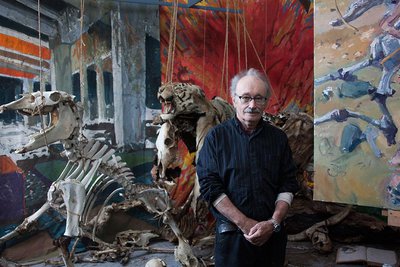
Henk Pander’s Portland studio is how I imagine an Old Masters’ pad — be it Vermeer, Rembrandt or Hals — in 17th-century Europe. Strewn about are remnants of still lifes, palettes with fat slabs of oil pigment and enormous canvases, all dwarfed by 20-foot ceilings. With the afternoon sun filtering in through skylights, it’s nothing short of glorious.
Here, the Dutch painter, based in the City of Roses, has rigged a horse skeleton and cow skeleton, the latter draped with the skin of a tiger, tied to a latticework hanging from the ceiling. Next to this macabre marionette, a huge canvas sits on an easel featuring a nude woman holding an assault rifle in some apocalyptic landscape.
“Artemis, the goddess of the hunt,” says Pander, motioning up to his work in progress, the hanging skeletons painted behind her with skulls rearing. “She murdered the whole living world around her.”
Pander, a Dutch painter who relocated to Portland from the Netherlands in 1965, is one of Oregon’s most iconic and, historically, controversial artists.
Turning 78 this month, Pander continues to paint every day. He comes to Lane Community College’s downtown campus for Lane Arts Council’s First Friday ArtTalk Nov. 6 when he will present his work.
His larger-than-life canvases are influenced by the composition and technique of the Dutch masters, while his imagery has more in common with the surreal and nightmarish scenes of Dalí or de Chirico.
He was commissioned to do the official portraits of two Oregon governors: Tom McCall in 1982 and John Kitzhaber in 2009, both who posed in his studio. (Look them up: These are anything but staid political portraits.)
And his work is featured in the collections of Amsterdam’s Rijksmuseum, NASA’s Jet Propulsion Laboratory in Pasadena, the Portland Art Museum and Eugene’s Jordan Schnitzer Museum of Art.
He also famously painted the wreck of the New Carissa freighter near Coos Bay. “The Burning of the New Carissa” is on view at Salem’s Hallie Ford Museum through Dec. 20.
In the ’60s, Pander shook the Portland art world with imagery that was considered too grotesque and sexually explicit for the tastes of the day.
“I made these incredibly vivid paintings — it caused a huge scandal,” Pander recalls. “Nobody wanted anything to do with me.”
Thus Pander carved out his own art niche in the world of theater, painting sets and backdrops for the Portland’s experimental Storefront Theater and others, before returning to canvas. “The drama of my paintings comes a lot out of that,” he says.
To this day, however renowned Pander and his paintings have become, he says he has difficultly finding support for his work.
“Nobody’s going to buy that,” he says. “They say: ‘It’s so weird and dark, and it’s too big.’”
He continues, “At the same time, I think it’s really important to make these kind of paintings.”
He’s right. That weirdness, that darkness, combined with the skills of an artist who was trained in the methods of the Old Masters, is precisely what makes his work so powerful and important. He combines challenging and contemporary themes with a classical arts education, a rarity in a post-post-modern art world.
Pander grew up in Nazi-occupied Haarlem, the Dutch city where Frans Hals once painted. Looking through Pander’s oeuvre, filled with large-format paintings of huge skies, strange landscapes and mammoth aircrafts — it’s clear that his Dutch environs and the Nazi occupation forever informed his mind’s eye.
“If you look at the traditional Dutch painting and if you have been in Holland, the skies play an enormously important role,” he says. He also recalls seeing World War II planes from his home as a little boy. “Right behind our house were searchlights — the Nazi searchlights in some schoolyard, and they’d scan the sky,” he says. “I’d see them out of my bedroom and occasionally planes would be caught in them and get flak from coastal guns.”
Upon moving to America, his fascination for planes transformed into a passion for technology and space. In the late ’80s, Pander joined NASA’s Art Team to observe and capture the construction of the Galileo, the spacecraft that went to Jupiter in 1989.
Now, Pander has turned his focus to the Hanford nuclear site along the Columbia River. “It’s probably one of the most important buildings in the world,” he says. He’s currently working on several paintings of the site, which he has photographically documented.
Towards the end of my visit to his studio, Pender says that since he was a young artist in Holland, he was always told that all an artist can do is paint a picture of his time.
“I moved from Holland to the heart of this huge super power in this enormous country, and I thought, I’m just going to paint it,” he explains.
“This is what I do, and I know exactly what I’m doing and why I’m doing it, and what everybody thinks? I don’t give a shit. It gives me a certain amount of freedom,” he says, laughing.
Henk Pander will give a talk and present images of his work for November’s First Friday ArtWalk 6 to 7 pm Friday, Nov. 6, followed by a reception, at LCC’s downtown campus; FREE.